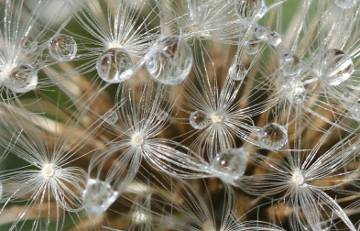

PHOTO COURTESY OF GARRY KESSLER
Dew on dandelion
January 18, 2013, Page PAGE
NATURE NOTES
By Annie Reid
Westborough Community Land Trust
Try the annual Nature Notes quiz
What’s in store for us this winter, in the usually frigid months of January and February? Will we get an overabundance of roof-crushing snow, as we did two years ago in 2011; or an unbelievably mild winter, like last year; or perhaps a regular New England winter, somewhere in-between?
Only time will tell. So far we’ve had some cold and snow in December, and a mild January thaw. Extremes are typical of New England weather, and they generally tend to balance out over time – record-low temperatures balancing record-high temperatures. So how can we tell if global warming is really taking place?
Some scientists have recently figured out that a clear imbalance between the number of record-low temperatures and record-high temperatures is a clue – or even evidence – that the climate is shifting in the direction of the greater number. In other words, if we get many more record highs than record lows over time, that’s evidence that our climate is warming. And vice versa, of course. As it turns out, in 2012 in the United States, record hot days outnumbered record cold days by 5 to 1. This imbalance suggests that the climate is warming.
But no matter what the weather, many plants and animals respond to light, and the days are already getting longer. The lengthening days stimulate plants and animals to produce hormones, which bring about changes in them. Are your houseplants growing more vigorously now? Did you hear a cardinal trying out its spring song early one recent morning? In a few months, we’ll be seeing dandelions.
Prepare for the awakening of nature in the months ahead by taking our annual nature quiz to jog your memory about our local plants and animals. Below you'll find short descriptions of Nature Notes topics from 2012. See if you can match these descriptions with answers from the alphabetical list that follows.
Choose your answers from the drop down lists. Check your answers by clicking the "Show Answers" button. The answer page will contain links to the 2012 “Nature Notes” columns so you can re-read them as a way of preparing to enjoy nature in 2013.
Let us know if all or almost all of your answers are correct! Email us your name (or your group’s name if a class or scout troop or other group is answering the quiz) at NatureNotes@westboroughlandtrust.org. We'll be pleased to congratulate the top scorers in a future issue of the Westborough News.
Match these descriptions with possible answers from the list below:
Possible answers:
-
American robin (Turdus migratorius)
-
Asian longhorned beetle (Anoplophora glabripennis)
-
Barred owls (Strix varia)
-
Blueberry (Vaccinium angustifolium, Vaccinium corymbosum)
-
Cinnamon fern and interrupted fern (Osmunda cinnamomea & Osmunda claytoniana)
-
Hairstreaks – gray, banded, and striped (Strymon melinus, Satyrium calanus,& Satyrium liparops)
-
Honey mushrooms (Armillaria mellea)
-
Pickerel-weed (Pontederia cordata)
-
Pine siskins (Carduelus pinus, Spinus pinus)
-
Rabbit’s foot clover (Trifolium arvense)
-
Ruffed grouse (Bonasa umbellus)
-
Virginia creeper (Parthenocissus quinquefolia)
-
Viscid violet cort (Cortinarius iodes) & Old man of the woods (Strobilomyces floccopus)
-
Wild oats (Uvularia sessilifolia)
Date index
Month (January)
Common name index
Scientific name index
Category index